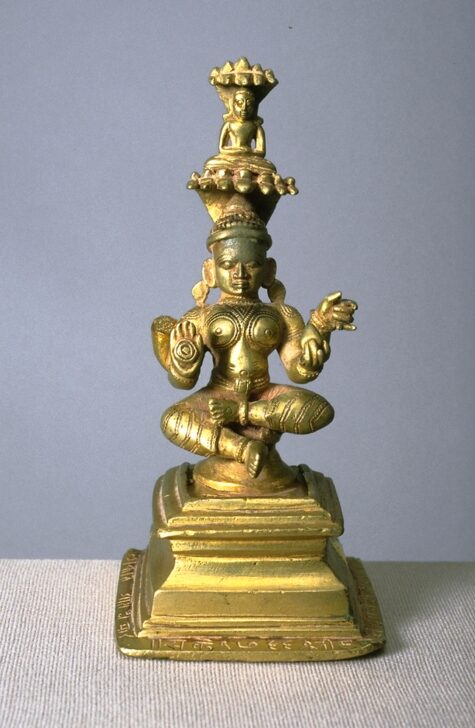Padmavati with Parshva
Indian

Description
March 28, 2009
Unlike Hindu icons, which rarely have inscriptions with historical information, many of the metal sculptures executed for the Jain faithful are inscribed and dated. One prominent scholar of Jain art attributes this habit to the predominance of scribal and administrative skills in occupations traditionally held by members of the Jain community. Forbidden by their beliefs to take up occupations that might involve killing, such as agriculture, animal husbandry or warfare, most Jains became merchants or bankers. This image of the four-armed snake goddess Padmavati (an attendant of the twenty-third tirthankara) is inscribed with the date VS 1766, or 1709.
(Label for UMMA South and Southeast Asia Gallery Opening Rotation, March 2009)
---
Unlike Hindu icons, which rarely have inscriptions with historical information, many of the metal sculptures executed for the Jain faithful are inscribed and dated. One prominent scholar of Jain art attributes this habit to the predominance of scribal and administrative skills in occupations traditionally held by members of the Jain community. Forbidden by their beliefs to take up occupations that might involve killing, such as agriculture, animal husbandry, or warfare, most Jains became merchants or bankers. This image of the four-armed snake goddess Padmavati (an attendant of the twenty-third tirthankara) is inscribed with the date VS 1766, or 1709.
(South and Southeast Asia Gallery Rotation, Fall 2010)
Gallery Rotation, Fall 2010
Padmavati with Parshva
India, Maharashtra
1709
Brass
Gift of Dr. and Mrs. Leo S. Figiel and Dr. and Mrs. Steven J. Figiel, 1977/2.47
Unlike Hindu icons, which rarely have inscriptions with historical information, many of the metal sculptures executed for the Jain faithful are inscribed and dated. One prominent scholar of Jain art attributes this habit to the predominance of scribal and administrative skills in occupations traditionally held by members of the Jain community. Forbidden by their beliefs to take up occupations that might involve killing, such as agriculture, animal husbandry, or warfare, most Jains became merchants or bankers. This image of the four-armed snake goddess Padmavati (an attendant of the twenty-third tirthankara) is inscribed with the date VS 1766, or 1709.
Subject Matter:
Another popular goddess in the Jaina tradition is the four-armed snake goddess Padmavati. Both Padmavati and Parshva, the twenty-third thirthankara with whom she is associated, are depicted under the shelter of a spreading cobra’s hood.
Unlike Hindu icons, which rarely have inscriptions with historical information, many of the metal sculptures executed for the Jain faithful are inscribed and dated. One prominent scholar of Jain art attributes this habit to the predominance of scribal and administrative skills in occupations traditionally held by members of Jain community. Forbidden by their beliefs to take up occupations that might involve killing, such as agriculture, animal husbandry, or warfare, most Jains became merchants or bankers. This image of the four-armed snake goddess Padmavati (an attendant of the twenty-third tirthankara), is inscribed with the date VS 1766, or 1709 CE.
Physical Description:
Padmavati sits on a raised tiered square base. She sits on a narrow rounded seat with one leg crossed in her lap and the other slightly pendant. She has four arms and the right back one is broken. On the palm of her front right hand which is in the gesture of reassurance. She holds a mango in her front left hand and the base of some vegetative form in the back left hand. Her tight fitting lower garment is decorated with incised lines in stripes and incised lines delineate her necklace and encircle her breasts. She wears large plain earrings [?] and a conical crown. Her head is surmounted by a seven headed snake hood, symbolizing her snake nature and seated atop the hood is a figure of the jina Pashva in a half lotus position and his hands folded in a gesture of meditation. He is turn is toped by a five headed snake hood signifying Padmavati’s consort the nagaraja Dharanendra.
Usage Rights:
If you are interested in using an image for a publication, please visit https://umma.umich.edu/request-image/ for more information and to fill out the online Image Rights and Reproductions Request Form.